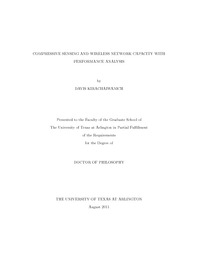| dc.description.abstract | This dissertation contains five reseach topics. In chapter 1, the performances of a noncoherent slow frequency-hopping system with M-ary frequency-shift-keyed modulation (NC-FH/MFSK) under various hostile jamming strategies are studied. Then, the knowledge obtained is used in developping a new "combined-jamming" interference model. The model can be used in analyzing the performance of NC- FH/MFSK networks, where transmissions from each network node can interfere with one another. An example application of the proposed model is the channel assignment in a multiradio FH/MFSK wireless mesh network (MR-FH/MFSK WMN). In chapter 2, the multiradio frequency-hopping wireless mesh networks (MR- WMN) is still being considered. However, the scope of the study is wider. Instead of having each node using NC-FH/MFSK modulation only, this chapter considers the a wider variety of modulation choices, such as M-PSK or M-QAM. To improve the throughput of MR-WMN, the space-time block coding (STBC) technique is introduced in the physical layer and a MAC-layer channel management is also used to combat against two major sources of deteriorations in wireless communications, the fading channel and cochannel interferences. With the STBC technique, both temporal and spatial diversities can be deployed; hence, the link performance can be improved in the presence of a fading channel. Then, to protect the link from cochannel interferences, an interference-aware algorithm is used to carefully bind the radio interfaces of the nodes to the frequency channels. Within the study, an additional adaptive transmission scheme is also proposed to aids in deciding an optimal number of antennas and selecting the best antenna set for the pending transmission. In chapter 3, the capacity of wireless hybrid networks, in which a wired network of base stations is used to support very long-range communications between wireless nodes, is investigated. By allowing more than one source node to transmit simul- taneously and utilizing successive interference cancellation to decode information at the destination node, a multiple access technique is being introduced to the network. The results show that, for a hybrid network containing n wireless nodes and a wired infrastructure of b = o( n log n) base stations, with the multiple access concept, the des- tination or the nearest base stations can receive information from the source nodes at the rate of O( b n log n b ). But when data is delivered to a node, because the base station is the only transmitter in the cell, it can forward the message to each node only at rate £( b n). This can be further improved by deploying an antenna array or increasing the transmission power of the base stations. In the last two parts of the dissertation, the compressive sensing (CS) is con- sidered. Compressive sensing can be considered as method to capture and represent compressible signals at a rate significantly below the Nyquist rate. In chapter 4, the compressive sensing scheme is considered from the information theory point of view and derive the lower bound of the probability of error for CS when length N of the information vector is large. The result has been shown that, for an i.i.d. (independent and identical) Gaussian distributed signal vector with unit variance, if the measurement matrix is chosen such that the ratio of the minimum and maximum eigenvalues of the covariance matrices is greater or equal to 4 (M K +1) , then the probability of error is lower bounded by a non-positive value; which implies that the information can be perfectly recovered from the CS scheme. On the other hand, if the measurement matrix is chosen such that the minimum and maximum eigenvalues of the covariance matrices are equal, then the error is unavoidable and the perfect recovery can never be achieved. One of the major challenges in the CS technique is how to design a reconstruction algorithm that can perfectly recover the compressed information. It is known that a family of algorithms using the Orthogonal Matching Pursuit (OMP) technique can offer fast reconstruction and simple geometry interpretation. However, when the compressed observation contains a great amount of noise, the performance of the OMP-based algorithms drops substantially. In chapter 5, a fuzzy forecasting reconstruction algorithm, which can help improving the OMP-based reconstruction algorithm, is proposed. Relying on a collection of the less noisy past information, the algorithm extracts the knowledge in the values of the current compressed infor- mation. Using such knowledge together with the noisy observation received, it can better extract both the values and the locations of the sparse coefficients in the information vector. The simulation results have shown that, compared to a standard OMP algorithm performance, an improvement in the ratio of signal to reconstruction error of up to 2 dB, at SNR=15 dB, can be achieved using the proposed approach. | en_US |


